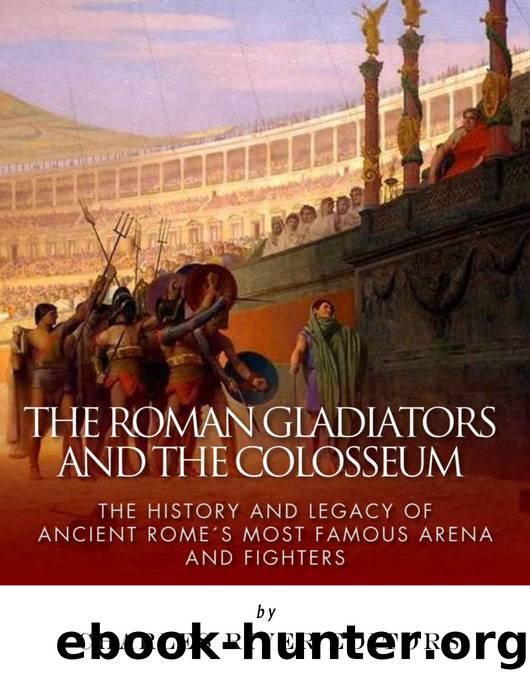The Roman Gladiators and the Colosseum: The History and Legacy of Ancient Romeâs Most Famous Arena and Fighters by Charles River Editors

Author:Charles River Editors
Language: eng
Format: epub
Publisher: Charles River Editors
Published: 2013-11-17T16:00:00+00:00
The Hoplomachus
A hoplomachus fighting a thraex
The name of this gladiator comes from Greek and means âfighting with weaponsâ. Naturally, this gladiator class refers to the famous Greek hoplite warriors, who carried a shield called the hoplon, and this gladiator class was better known in the western part of the Roman Empire. The hoplomachus occasionally fought against the thraex gladiator, but he was more commonly paired against a murmillo fighter (though this latter pairing was much less common than the murmillo fighting the thraex).[54]
The hoplomachus was equipped with a helmet, shield, greaves and an armguard on his right arm. The helmet was broad-brimmed with a visor, and it was decorated with a forward curving crest and a feather, which could be placed on either side. Thus, this helmet closely resembled the helmet of the thraex gladiator. The shield was small, concave and rounded, made of a single sheet of metal (usually bronze), and looked much like the Greek hoplite shield. The back of the shield also had a broad bronze strip along the center, forming a stirrup where the fighter could place his lower arm. He could then grasp a leather loop fitted to the border of the shield.
As with the Greek hoplites, the structure of the hoplomachus shield allowed the gladiator to hold a dagger or short sword as his secondary weapon. His primary weapon was a lance, but if it was broken, lost or discarded, the hoplomachus could easily transfer his secondary weapon to his right hand. Presumably, the lance was used and discarded quickly because it would not have been a great one-handed offensive weapon.
Since this gladiator type only wore a loincloth with an accompanying belt and nothing on his torso, along with a small shield that did not offer much protection for his legs, this gladiator wore greaves on each leg that both reached as high as the middle of his thigh. Under them was cloth padding, which helped cover the upper part of the thigh and made the greaves more comfortable to wear. Based on images, the padding could be decorated with embroidery.[55]
Download
This site does not store any files on its server. We only index and link to content provided by other sites. Please contact the content providers to delete copyright contents if any and email us, we'll remove relevant links or contents immediately.
The Daily Stoic by Holiday Ryan & Hanselman Stephen(3110)
The Fate of Rome: Climate, Disease, and the End of an Empire (The Princeton History of the Ancient World) by Kyle Harper(2874)
People of the Earth: An Introduction to World Prehistory by Dr. Brian Fagan & Nadia Durrani(2619)
Ancient Worlds by Michael Scott(2493)
Babylon's Ark by Lawrence Anthony(2433)
Foreign Devils on the Silk Road: The Search for the Lost Treasures of Central Asia by Peter Hopkirk(2388)
The Daily Stoic by Ryan Holiday & Stephen Hanselman(2344)
India's Ancient Past by R.S. Sharma(2298)
MOSES THE EGYPTIAN by Jan Assmann(2275)
The Complete Dead Sea Scrolls in English (7th Edition) (Penguin Classics) by Geza Vermes(2135)
Lost Technologies of Ancient Egypt by Christopher Dunn(2111)
The Earth Chronicles Handbook by Zecharia Sitchin(2101)
24 Hours in Ancient Rome by Philip Matyszak(1973)
Alexander the Great by Philip Freeman(1960)
Aztec by Gary Jennings(1879)
The Nine Waves of Creation by Carl Johan Calleman(1784)
Curse Tablets and Binding Spells from the Ancient World by Gager John G.;(1768)
Before Atlantis by Frank Joseph(1740)
Earthmare: The Lost Book of Wars by Cergat(1715)
